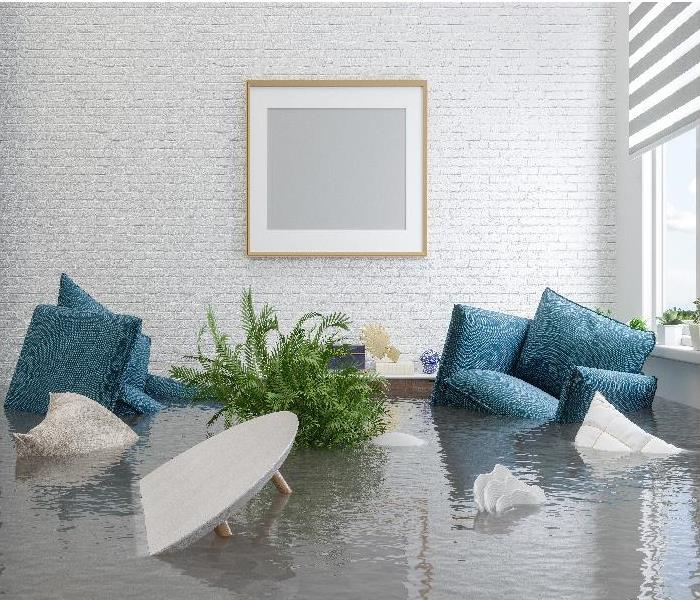How Does Water Get Removed from Different Materials in South Daytona?
9/7/2020 (Permalink)
We always seek to restore your South Daytona home over the replacement of materials, so understanding how to dry exposed elements can make this process successful.
As overwhelming as a water disaster might seem in your South Daytona home or business, swift action from professional water restoration companies like our SERVPRO team can help. We approach every emergency with the urgency it is due, as standing water and exposure can irreparably harm structural elements and contents of the house. While some of the restorations for exposed materials can happen without much trouble, several construction choices have a rigid restoration timeline.
Homes are not constructed with a single type of material, meaning that the water damage restoration for South Daytona properties involves multiple approaches, equipment, and strategies. The way that wall systems get dried and restored varies from the damage that flooring materials might endure after prolonged exposure. Despite the changes in how we address and overcome drying obstacles in a property after a disaster, we must evaluate and assess impacted structural elements with the same categorizing factors. These include the porosity of the material, the steps for drying it, and at what point controlled demolition becomes inevitable.
How Does Drywall Become Damaged?
Because of its typical use in modern homes, drywall is often one of the universally exposed construction materials in both residences and businesses. While internal elements like the framing might change with commercial construction, drywall is the cheapest wall surface that can be painted or covered to the preferences of the owner. With how easily gypsum can fall victim to pooling water or heightened moisture contents, it is critical to understand the best approach to protect these materials when possible and the rest of the structure when it is not.
• Porosity/Permeance – In the realm of construction materials, drywall is among the most porous and able to pass water. This high porosity means that complete exposure and eventual oversaturation can happen on a short timetable.
• Drying – If it is deemed possible to dry out sheetrock after exposure, this often happens with centrifugal air movers positioned at the problem areas.
• Controlled Demolition – Drywall is often removed after exposure because this is a low-cost material. It usually costs more to attempt to restore it and clean it than it would to replace it with a new sheet.
Can Carpeted Floors Get Successfully Dried?
Carpets are also a staple of modern construction for their feel and look in the living space. Water damage occurring around these materials can show the high sensitivities of carpet materials to pooling water and moisture concerns. Evaluating the likelihood of removing this water damage before irreparable harm occurs saves time for restoration and recovery.
• Porosity/Permeance – Carpets are hygroscopic materials, meaning that they are immediately impacted by water exposure and can absorb water vapor in the air.
• Drying – When the drying process begins quickly, hygroscopic materials are among the first to recover when irreversible damages have not already taken place.
• Controlled Demolition – The need for controlled demolition might not always exist for the upper surface layer. The carpet itself is more resilient to damage and drying than the padding underneath.
Do Wooden Elements Like Flooring and Framing Fair Better?
Wood is not impermeable, so this material can also show signs of damage and harm after exposure to water damage effects. Because many water disasters begin in structural cavities, framing can often become exposed to water before flooring materials or drywall.
• Porosity/Permeance - Wood in either flooring or framework is considered semi-porous. While these surfaces do not absorb moisture as fast as carpets and sheetrock, they can experience the same absolute damages.
• Drying – For flooring that becomes damaged by exposure of standing water, we can remove surface threats with squeegee wands and extractors. Pulling moisture from the flooring or framing involves drying mats, air movers, and dehumidifiers.
• Controlled Demolition – If approached quickly enough by our qualified SERVPRO team, controlled demolition is not often necessary. Prolonged exposure can lead to warping and distortion of the wood, which requires removal and replacement.
Do Unfinished Materials Become Damaged Faster?
When damage to unfinished materials like the framing and plywood in an attic or supports in a basement becomes exposed to water and vapor, they can be more readily damaged. Without treatments or coverings for the materials, such as a finish on wood flooring, you have no vapor barriers to protect the material substrate, so absorption and subsequent damage occurs at a more accelerated rate.
Understanding how different materials get dried and protected after a disaster ensures that professionals like our SERVPRO of South Daytona Beach / Port Orange are doing the most to restore and repair the property. Give us a call anytime at (386) 788-0358.






 24/7 Emergency Service
24/7 Emergency Service
